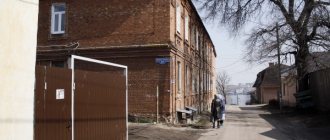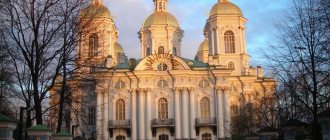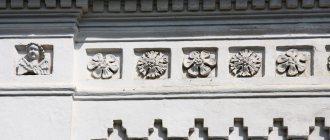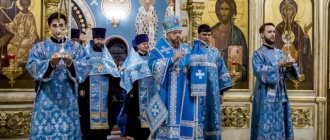Naval St. Nicholas Cathedral - one of the main attractions of Kronstadt. This is not only the main temple of the Russian Navy, but also a branch of the Central Naval Museum, a monument to fallen sailors. It is a landmark for ships and vessels traveling along the Kronstadt naval fairway: its golden cross and silver dome, decorated with golden anchors, are visible from afar.
Naval St. Nicholas Cathedral
History of the construction of the Naval St. Nicholas Cathedral
Kronstadt is a maritime city. Once upon a time there was a small maritime church of the Epiphany. However, it could not accommodate everyone, and therefore the idea of building a new, large cathedral was repeatedly expressed.
In 1896, Vice Admiral Nikolai Ivanovich Kaznakov (1834-1906, from 1901 - admiral), who at that time held the position of chief commander of the Kronstadt port, submitted a petition for the construction of a new cathedral in Kronstadt:
... which in its grandeur would correspond to the significance of Kronstadt as the cradle of the Russian fleet and would be a worthy monument both to the ranks of the Naval Department who died in the line of duty, and to outstanding figures who contributed to the development and glory of the fleet. — Quote. by: V.Ya.Krestyaninov. Kronstadt. Fortress, city, port. St. Petersburg, 2014. P.61
In 1897, the collection of donations for the construction of the Naval Cathedral began. The main amount was collected by sailors, who, until 1913, contributed a quarter of a percent of their salaries to the Naval Cathedral. In 1900, a committee for the construction of the cathedral was established, which was headed by the chief commander of the Kronstadt port, Vice Admiral Stepan Osipovich Makarov (1848-1904).
Initially, Nicholas II approved the project of the architect A.I. Tomishko, which, however, was criticized by the committee for the construction of the cathedral. Then the development of the project was entrusted to the famous architect Vasily Antonovich Kosyakov (1862-1921), the author of a number of civil and religious buildings, including for the military department: the Church of the Merciful Mother of God in Galernaya Harbor (St. Petersburg), the Church of the Epiphany in the port on Gutuevsky Island (St. Petersburg), the Church of St. Nicholas the Wonderworker in the Naval Hospital (Kronstadt), the Naval Cathedral in the port of Emperor Alexander III (Libava, now Liepaja, Latvia) and others.
The new temple was supposed to become not just a naval cathedral, but, above all, a monument to all the sailors who died in the performance of their duty. Thus, the “Brief Note on the Construction of the Cathedral” said:
Both when drawing up, and during the development and implementation of the project of the Naval Cathedral in Kronstadt, the main idea of the Committee for the construction of the cathedral was not only to satisfy the religious needs of the Kronstadt sailors, but also to create a cathedral-monument in which the names of the sailors who died since 1696 would be collected g. in the performance of their duty, ship icons and other relics of the fleet. — Quote. by: V.Ya.Krestyaninov. Kronstadt. Fortress, city, port. St. Petersburg, 2014. P.62
On October 27, 1901, clearing of the site for construction began - on Anchor Square , where old anchors were previously stored. On September 1 (14), 1902, after a solemn prayer service performed by John of Kronstadt and in the presence of Vice Admiral S.O. Makarov, construction began. On May 8 (21), 1903, the ceremonial laying of the walls took place, which was attended by Emperor Nicholas II and members of the imperial family.
On June 10 (23), 1913, the Naval Cathedral was consecrated in the name of St. Nicholas the Wonderworker, patron saint of sailors and all travelers. The consecration ceremony of the cathedral was conducted by the protopresbyter of the military and naval clergy, Father Georgy Shavelsky, co-served by the rector of the St. Petersburg Admiralty Cathedral, mitered archpriest Alexy Stavrovsky, and the Kronstadt clergy.
The culmination of the development of the idea of a military temple-monument was the Kronstadt Naval Cathedral - the main temple of the entire Russian fleet. In its design, structure, and the traditions that formed within it, the Naval Cathedral was the result of a long process of development of the temple-monument complex, which became a kind of symbolic mass grave of sailors buried in the depths of the sea, and included a temple - a place of prayerful commemoration of fallen heroes, a repository relics, and a monument to military glory. As a result of development, the Naval Cathedral has absorbed all the best that has been developed over many decades of the existence of military churches. — Elena Isakova. Kronstadt Naval Cathedral in the Orthodox tradition of patriotic education in the navy
Behind the Naval Cathedral in 1911-1914, garden master E.G. Gilbikh laid out the Cathedral Square.
In 1913, a monument was erected on Anchor Square to the outstanding Russian naval commander, oceanographer, polar explorer, shipbuilder, Vice Admiral Stepan Osipovich Makarov , who died on March 31 (April 13), 1904 near Port Arthur, during the Russo-Japanese War.
Monument to Stepan Osipovich Makarov
Excursions
The Naval Cathedral is one of the main attractions of Kronstadt. Therefore, almost no excursion is complete without visiting the temple. Excursions are organized by both excursion bureaus and private individuals.
For example, a 7-hour bus tour of the sights of Kronstadt (with a visit to St. Nicholas Cathedral) costs 1,090 rubles. for an adult and 990 rub. for a child (departure from St. Petersburg).
A tour conducted by local historians can cost 3 – 3.5 thousand rubles. for a group of 10 people.
Naval St. Nicholas Cathedral in the Soviet years and today
It is difficult to imagine what tragic fate awaited the Naval St. Nicholas Cathedral during the Soviet years. On June 1, 1929, the last service took place in the Naval Cathedral, after which the temple was closed and looted. The beautiful iconostasis was destroyed. Instead of a cross, it was proposed to install a star or a statue of Lenin on the dome. Thus, the newspaper “Red Baltic Fleet” wrote:
The statue of Ilyich should stand with an outstretched arm towards the sea, as if inviting foreign workers to visit the USSR. — Quote. by: V.Ya.Krestyaninov. Kronstadt. Fortress. City. Port. St. Petersburg, 2014. P.64
In 1932, part of the cathedral’s premises was occupied by the Maxim Gorky club, which was popularly called “Maksimka”, and the other was given over to warehouses. During the Great Patriotic War, an observation and correction post for the naval and coastal artillery of Kronstadt was located under the dome. In the northern part of the cathedral, on the floor there is a trace left from an unexploded German bomb that pierced the dome in 1943.
In the 1950s, a suspended ceiling was built, which separated the auditorium from the dome part. On February 22, 1955, the Kronstadt Fortress club opened in the former Naval Cathedral.
The wind blew through the broken windows and rain poured, and the stars visible on the dome could be confused with real ones. Pigeons settled here for many decades. Only on the cracked wall was the face of a cherub, pale from the weather, visible... - E.V. Isakova, M.V. Shkarovsky. Temples of Kronstadt. St. Petersburg, 2004. pp. 180-182
Club in the former Naval Cathedral of Kronstadt
In 1976, the building of the former cathedral was taken under protection as an architectural monument. In 1978, the Sailors' Club opened here, which existed until 1989. Also, since the 1980s, the Kronstadt Fortress museum has functioned here.
By the early 2000s, the former Naval St. Nicholas Cathedral was a sad sight. Although its owner, the Marine Engineering Service, tried to maintain the safety of the building, there was a catastrophic lack of money for maintenance, especially after the crisis of the 1990s. There were frequent floods on the ground floor caused by the rupture of old, pre-revolutionary pipes.
The question of transferring the temple to the Russian Orthodox Church, but with the preservation of the cathedral as a naval cathedral, was repeatedly raised. However, the Church did not have money for the maintenance and restoration of this unique temple at that time.
Nevertheless, on November 2, 2005, the first Liturgy was served in the Naval St. Nicholas Cathedral. In 2007, it was transferred to the balance of the Central Naval Museum. However, the repair work carried out at that time was fragmentary, and destruction continued. In 2009, after the cracks in the walls and dome increased significantly, the cathedral building was declared unsafe and in need of urgent restoration.
Just like a hundred years ago, the whole world raised funds for the restoration of the Naval Cathedral. Once again, sailors made the largest financial contribution, but donations also came from ordinary citizens and large corporations. The money was accumulated by the international charitable foundation “Kronstadt Naval Cathedral in the name of St. Nicholas the Wonderworker.” A Public Trustee Council was created.
To preserve the building, in 2009 it was dressed in a special protective sarcophagus made of reinforced film. Restoration work proceeded at a rapid pace. Lost details of the interior decoration, mosaics, and stained glass windows were restored using old photographs and drawings. It is especially worth noting the many years of work of Elena Isakova, who painstakingly restored memorial plaques with the names of the dead sailors.
Protective sarcophagus of the Naval Cathedral in Kronstadt (photo from the Internet)
On April 24, 2012, Patriarch Kirill of Moscow and All Rus', in the presence of Russian President D.A. Medvedev, performed the rite of the Minor Consecration of the Cathedral. On May 28, 2013, on the centenary of the consecration of the Naval St. Nicholas Cathedral, Patriarch Theophilus of Jerusalem and Patriarch Kirill of Moscow and All Rus' performed the rite of the Great Consecration and the Divine Liturgy.
Naval Cathedral, southern facade
Nowadays, the Naval Cathedral in Kronstadt performs a double function. It is the main temple of the Russian Navy. He is also stauropegial, that is, directly subordinate to the Patriarch. At the same time, it is a branch of the Central Military History Museum. But, first of all, the Naval St. Nicholas Cathedral is a monument to all sailors who died defending their fatherland - Russia.
[The Naval Cathedral was conceived] as a temple-monument in which an atoning bloodless sacrifice would be offered daily, [and which] would serve at the same time as a connecting link of the past, present and future of the Russian fleet, an eternal witness to the works, knowledge, exploits that served to glory homeland and fleet. — Russian State Administration of the Navy f.427 op.3 d.177. Quote by: Elena Isakova. Kronstadt Naval Cathedral in the Orthodox tradition of patriotic education in the navy.
Mosaic panel “Triumph of the Russian Fleet” near the Naval St. Nicholas Cathedral
As before, a majestic monument to Admiral Makarov stands on Anchor Square. Not far from it is a monument to the fighters for Soviet power, in the form of a pyramid, in the center of which an eternal flame burns. Anchor Square is decorated with a huge anchor with a cross inscribed in it and the silhouette of a temple around it, which resembles an ancient Russian military helmet.
Naval Cathedral in Kronstadt, photo by Nikolai Ivanov, St. Petersburg
The Great Patriotic War and the post-war period
With the arrival of fascist troops, an observation platform was equipped on the dome of the Naval Cathedral. It functioned until the blockade was lifted. Despite all the efforts of the townspeople, during the war several shells hit the temple, the holes from which were subsequently repaired, and repairs were made inside the building.
After the end of hostilities, a new idea arose: to equip a cinema and concert hall in the Naval Cathedral. As a result of major construction work, a suspended ceiling, balcony, stage and wall partitions were installed. The alteration of the premises was carried out until 1954, and its result was a violation of the integrity of the walls of the temple - numerous cracks appeared along them. In February 1955, the hall was inaugurated. Evenings, concerts, and various entertainment events were held here. After the reduction of the garrison in the 60s. the hall again became one of the branches of the House of Officers.
External appearance and interior decoration of the Kronstadt Naval Cathedral
The Naval St. Nicholas Cathedral is a replica of the Constantinople Church of Hagia Sophia, but with slightly reduced and modified proportions. Architect Kosyakov made a special trip to Constantinople to take measurements of Hagia Sophia. The length of the St. Nicholas Naval Cathedral is 83.2 m, width - 64 m, dome diameter - 26.7 m, height to the base of the main dome - 52 m, height from the ground to the highest point of the cross - 75 m. The central part under the dome could accommodate 3000 those praying.
Naval St. Nicholas Cathedral
The huge dome sparkling in the sun and the cross above it are visible from afar, serving as a guide for sailors. This feels like a kind of echo with the never-realized project of Peter I to build a 213-meter lighthouse tower in the center of Kronstadt.
Dome of the Naval St. Nicholas Cathedral
The base of the Naval Cathedral is lined with light granite, the walls are gray-yellow brick and terracotta. Above the entrances there are mosaic inserts created in the workshop of V.A. Frolov: the image of the Mother of God above the northern gate, St. Mitrophania - above the southern one. The western facade is decorated with mosaic panels with images of the Holy Apostles Peter and Paul (left), St. Nicholas the Wonderworker and St. John of Rila (right). In the niche of the main entrance from Anchor Square there is a chapel of the Savior Not Made by Hands.
Western facade of the Naval St. Nicholas Cathedral
The interior decoration of the Naval Cathedral is striking in its luxury. It uses mosaics with a predominance of gold, blue and light gray colors and frescoes. Thanks to the transition from dark granite in the design of the lower tier to gold and sky-blue mosaics under the dome, the effect of the cathedral reaching up to the heavens is achieved. On a clear sunny day, a particularly strong feeling of radiance is created inside the cathedral.
The altar is raised 4 meters. Iconostasis by sculptor N.A. Popov according to the design of V.A. and G.A. Kosyakov is made of natural white and colored Ural marble. It is decorated with mosaic inserts and bronze details. The two-tiered galleries are supported by artificial marble columns. The altar, sails and vaults of the northern and southern choirs are decorated with paintings by the artist M.M. Vasiliev, made to resemble mosaics and frescoes.
The main altar of the Naval Cathedral was consecrated in the name of St. Nicholas the Wonderworker, the right one - in the name of the Holy Apostles Peter and Paul, the left one - in the name of St. John of Rila and in honor of the holy righteous John of Kronstadt.
Interior decoration of the Naval St. Nicholas Cathedral
Interior decoration of the Naval St. Nicholas Cathedral
Side galleries
Interior decoration of the Naval St. Nicholas Cathedral
Second tier gallery
Interior decoration of the Naval St. Nicholas Cathedral, western stained glass window with the image of “Deesis”
Iconostasis of the Naval St. Nicholas Cathedral
Domes of the Naval St. Nicholas Cathedral
The granite mosaic floor in a thin copper frame, with images of various animals, birds and sea monsters, is extremely beautiful.
Mosaic floor
The Naval Cathedral is not only a temple, but also a museum. It contains ship icons, banners, models of ships lost in naval battles and other exhibits dedicated to the glorious history of the Russian fleet.
Model of the Naval St. Nicholas Cathedral
Model of the squadron battleship Borodino, which distinguished itself in the Battle of Tsushima. Died on May 14 (27), 1905, sinking with almost the entire crew (865 people). Only one person survived
But here, perhaps, is the main thing for which you need to go to the Naval St. Nicholas Cathedral in the first place: memorial plaques made of black marble, where the names of the dead sailors are carved in gold letters. The names of the deceased clergy are carved on white marble boards. Here the entire history of the Russian fleet passes before your eyes.
There are 130 boards in total, some of them are empty. The names of future heroes will be entered here. Now about 1,000 names of sailors who died between 1695 and 1910 are carved here and are remembered during their service.
The names of all those killed, not only in battles, but also in the line of duty, officer ranks of the naval department (naval corps, admiralty, civil and medical ranks, clergy and midshipmen) should be written on the memorial plaques in the Cathedral. Religions are indifferent, both Christian and non-Christian. — Russian State Administration of the Navy f.427 op.3 d. 782 l.10. Quote by: Elena Isakova. Kronstadt Naval Cathedral in the Orthodox tradition of patriotic education in the navy.
Memorial plaques dedicated to the Defense of Sevastopol 1854-1855
Inscription dedicated to Admiral Nakhimov
There are also inscriptions dedicated to campaigns abroad, for example, the suppression of the Boxer Rebellion in China (1898-1901).
Losses of Russian sailors during the Boxer Rebellion in China
Total information
In its appearance, the Naval Cathedral of St. Nicholas the Wonderworker resembles the St. Sophia Church in Istanbul. Its structure is almost identical to the Turkish religious museum, but has much smaller dimensions: the length of St. Nicholas Cathedral is 83 m, the width is 64 m, and the height (including the cross) is just over 70 m.
At the same time, the St. Nicholas Church, in its main part, can accommodate about 3 thousand people.
The Naval Cathedral in Kronstadt ranks second in size in Russia after the Moscow Cathedral of Christ the Savior.
Information for visitors
Address of the Naval St. Nicholas Cathedral : Russia, St. Petersburg, Kronstadt, Anchor Square, 1.
Opening hours : daily from 9.30 to 18.00.
Divine services are held twice a day: at 10.00 and at 18.00.
*When writing the article, materials from the book by V.Ya. Krestyaninov “Kronstadt. Fortress, city, port", St. Petersburg, 2014.
© Website “On the Roads of the Middle Way”, 2009-2021. Copying and reprinting of any materials and photographs from the site anashina.com in electronic publications and printed publications is prohibited.
How to get there?
You can get to the cathedral by car, regular bus or boat.
You can get from St. Petersburg to Kronstadt in this way:
| № | St. Petersburg, metro station | Kind of transport | ||
| Bus | Minibus taxi | Boat (from late April to mid-November) | ||
| 1. | "Old village" | №101 | №510 | – |
| 2. | "etc. Enlightenment" | – | №407 | – |
| 3. | "Black River" | – | №405 | – |
| 4. | "Lenin Square" | – | – | from the Arsenalnaya Embankment pier (pier No. 1, along route 7) |
| 5. | "Vasileostrovskaya" (or "Sportivnaya") | – | – | from the Tuchkov Most pier (pier No. 2) |
| 6. | "Admiralteyskaya" | – | – | An excursion boat departs from pier No. 3 (Palace Bridge) |
The distance from St. Petersburg to Kronstadt is a little over 50 km. By car, such a journey will take 45–50 minutes. Taxis and buses run around the city to the cathedral (bus routes 1KR, 3KR are suitable).
The bus stops closest to the temple are:
- "Roshal Square";
- "Summer garden";
- "Makarov Gate";
- "st. Petrovskaya".
Attractions nearby
Everyone who comes here first ends up on Anchor Square. This is a huge space in front of the temple. We were in Kronstadt after the New Year, so the main object on the square was the New Year tree.











